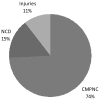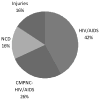Out of sync? Demographic and other social science research on health conditions in developing countries
- PMID: 21603127
- PMCID: PMC3097127
- DOI: 10.4054/DemRes.2011.24.2
Out of sync? Demographic and other social science research on health conditions in developing countries
Abstract
In this paper, we present a framework for considering whether the marginal social benefits of demographic and social science research on various health conditions in developing countries are likely to be relatively high. Based on this framework, we argue that the relative current and future predicted prevalence of burdens of different health/disease conditions, as measured by disability-adjusted life years (DALYs), provide a fairly accurate reflection of some important factors related to the relative marginal social benefits of demographic and social science research on different health conditions. World Health Organization (WHO) DALYs projections for 2005-30 are compared with (a) demographic and other social science studies on health in developing countries during 1990-2005, and (b) presentations made at the Population Association of America annual meetings during the same time period. These comparisons suggest that recent demographic and social science research on health in developing countries has focused too much on HIV/AIDS, and too little on non-communicable diseases.
Figures






















References
-
- Bongaarts J, Over M. Response. Science. 2010b October;330:177–178. doi: 10.1126/science.330.6001.177. - DOI
- Copenhagen Consensus. 2008.
-
- Copenhagen Consensus 2008 – Results. http://www.copenhagenconsensus.com.
Grants and funding
LinkOut - more resources
Full Text Sources
